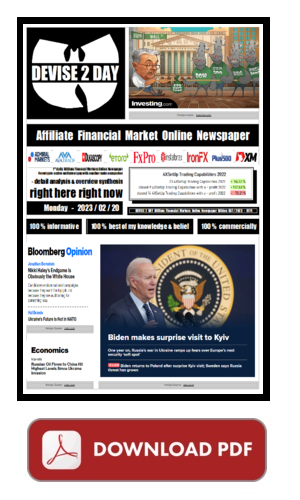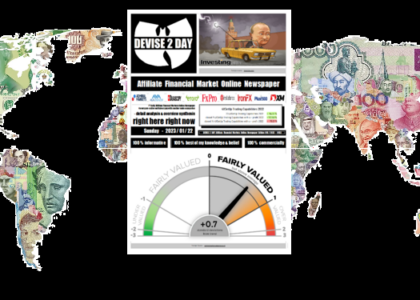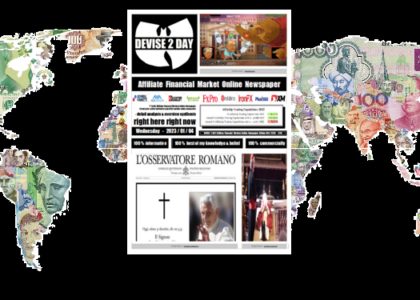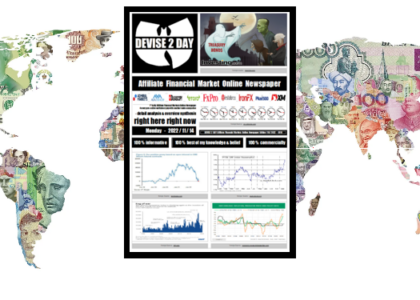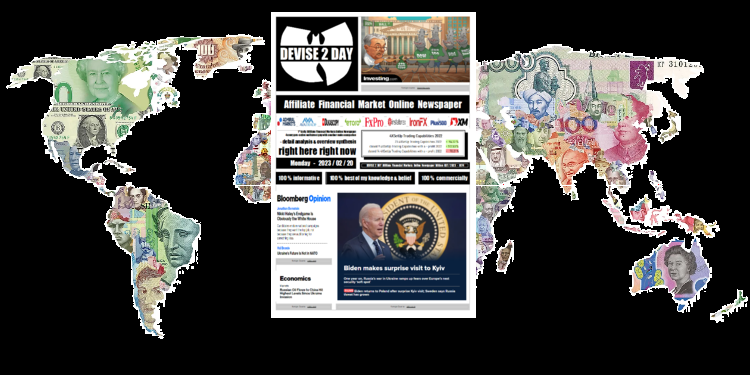
2023/02/20 (174) Column
The Financial Market
Will Not Remain A Calm Sea In 2023 Either!
The price action in the financial market is likely to become rougher and more choppy.
Barry Gill, Head of Investments at UBS, used the following words to sketch the same vision for 2023, if I am not mistaken: “Having lived in such calm waters for many years, we are now being challenged to embrace a world in which unpredictability is ever present. Nevertheless, the investment environment is likely to become more constructive over the next year,” he wrote in late 2022 in the annual outlook for this year 2023. Anticipate interest rate cuts and higher growth. “However, in early 2023, high inflation, rising interest rates and slowing growth expectations support a relatively dovish stance on risky assets,” he wrote.
For 2023 it is therefore advisable to invest more defensively and value-oriented.
As defensive sectors usually prove to be relatively independent of a weakening economy, while ‘value’ stocks tend to do well when inflation is high. More attractive buying opportunities for cyclical stocks and or even growth stocks could emerge in the second half of 2023 when inflation eases and global growth picks up.I expect US inflation to fall below the current interest rate as early as July 2023. Likewise, a fall in inflation to up to 2% , until the end of 2023. So that 2024 should only be a time when the USA will grow out of the US stagflation again, i.e. at the same time has higher growth rates than inflation concerns. That is why the Swiss advise to look for “uncorrelated hedge fund Strategies.” Macro, low net equity long short, and multi-strategy funds could help por to diversify portfolios against a backdrop of periodically elevated correlations between stocks and bonds”. And that’s exactly why i choosed all our previous 4XSetUp Trading Capabilities. Because these periodically increased correlations between stocks and/or bonds will probably continue…
DEVISE 2 DAY 48h
– Last News About What Drives The News Media
Biden’s historic trip to Kiev – an affair of the heart
Shortly before the anniversary of the start of the war in Ukraine, US President Joe Biden is visiting the capital Kiev. It’s a powerful image for the world, it’s a grand gesture for the Ukrainians — and an affront to Kremlin chief Putin. More civilized non-militant politics is not possible.
US President Joe Biden is in the middle of Kiev. Next to him the Ukrainian head of state Volodymyr Zelenskyj. The sun is shining, Biden is wearing his aviator sunglasses. At times, air raid alarms rang out in the Ukrainian capital on this memorable Monday. Zelenskyj speaks of a “historic” and “brave” visit when he greets his counterpart from the USA on the red carpet in the presidential palace. The 45-year-old smiles proudly at his wife Olena Selenska’s side. As the anniversary of Russia’s invasion of Ukraine approaches, Biden pays a surprise and dramatic lightning visit to the country, sending an important message to Ukraine and the world, but also to Russian President Vladimir Putin.
Biden arrives in Kiev early Monday morning and only leaves the metropolis around noon. In the few hours in between, the 80-year-old visits the world-famous Michael’s Monastery next to the presidential palace, walks past holy images in a dark coat and a tie in the Ukrainian national colors of blue and yellow at Zelenskyj’s side – right in the heart of the city. Photos of fallen soldiers with names and dates of life can also be seen on the walls of the monastery. It’s hundreds.
“Putin thought that Ukraine was weak and the West was divided. He thought he could take us by surprise,” says Biden. “I don’t think he thinks that anymore.” The western allies have already delivered 700 tanks, thousands of armored personnel carriers and artillery systems and almost two million artillery shells to Kiev, he says. And announces even more supplies.
Biden’s name will be immortalized on a memorial plaque on the square in front of Parliament – like that of Poland’s President Andrzej Duda and EU Commission President Ursula von der Leyen. A special honor. Only a few make it to the “Allee of the Brave”. Neither Chancellor Olaf Scholz nor French President Emmanuel Macron, who traveled to Kiev in June, were honored in this way.
The United States is Kiev’s most powerful ally. The Americans have pledged almost $30 billion in arms and ammunition to Ukraine since the war began. There is also humanitarian and economic aid. Biden brings new financial commitments to his visit to Kiev – and above all the announcement: We will continue to support you as long as you need us. We won’t leave you alone. Biden has said this many times, but the message is more powerful when he delivers it personally to Zelenskyy and the Ukrainians in the middle of Kiev.Biden was a long time coming with his visit. In recent months, one European head of government after another has rushed to Kiev, some more than once. Biden sent several high-ranking members of the government to Ukraine – and his wife. Only he himself did not travel there for a long time. The safety risks are too great, the logistical tour de force too great.
The visit at this point in time has all the more symbolic power: four days before the gloomy anniversary of the start of the war and one day before Putin wants to address his nation with a speech, the leader of the West travels to the heart of the war country. Rather than choosing a more remote, safer location near the border with Poland, Biden chose to visit the proud heart of Ukraine: the capital, Kiev. The fact that he stays here for several hours, visits several symbolic places with Zelenskyj, walks side by side through the city next to him under the open sky while the air raid alarm sounds, is a real demonstration of power towards Putin. Even if the Russian side was informed a few hours beforehand, as Biden’s national security adviser, Jake Sullivan, reveals.
DEVISE 2 DAY Another 48h
– Last News About How Drives The Price Action
A lack of impulses from the US stock exchanges ensured very quiet trading on the European stock markets on Monday. Major indices remained close to their Friday levels. “As US stock exchanges remained closed for the Presidents Day holiday, trading in European markets was calm and subdued with no clear direction,” said Michael Hewson of CMC Markets UK, summarizing the start of the week.
The EuroStoxx 50 ended the day down 0.09 percent to 4221.18 points. At the country level, the French Cac 40, which climbed to a record high last Thursday, fell 0.16 percent to 7335.61 points. Britain’s FTSE 100, which also hit a record high recently, rose 0.12 percent to 8,014.31 points.
Biden’s surprise visit to Kiev after originally scheduled to fly to Poland tomorrow was the topic of the day. So that I also decided to make it the cover photo on the first page today. Although the financial markets hardly reacted to it! Why? There is no greater political scenario! Or did I miss something?
Forex 10Y Government Bonds Stock Markets
Russian Ruble Hovers at 10-Month Low Russian Bond Yields Surge to 10-Month High China Stocks Jump on Economic Optimism
Korean Won Depreciates to 2-Month Low Swiss Bond Yields Hover at 7-Week High Russian Shares Rebound on Monday
Chinese Yuan Muted After PBOC Decision German 10-Year Bond Yield Steadies Around 2.5% FTSE 100 Closes Flat
Dollar Firms Up on Hawkish Fed Outlook European Shares Muted in Choppy Trade
Forex
Russian Ruble Hovers at 10-Month Low
Korean Won Depreciates to 2-Month Low
Chinese Yuan Muted After PBOC Decision
Dollar Firms Up on Hawkish Fed Outlook
Russian Ruble Hovers at 10-Month Low
The Russian ruble hovered below 74 per USD in late February, its lowest level since April 2022, amid poor foreign currency inflows to the national economy. Sanctions and embargos on the country’s energy exports compounded the impact of decreased international energy prices, reducing turnover for Russia’s vital revenue source and limiting demand for the local currency. Lower energy sales hurt the ruble despite intervention by the Central Bank of Russia, which has been selling an average of RUB 8.9 billion worth of foreign currency per day since January to offset depressed capital inflows. Adding to the bearish momentum, Russian demand for foreign currencies is seen recovering as domestic companies rebuild supply chains and increase import levels after Western sanctions.Korean Won Depreciates to 2-Month Low
The Korean won traded around 1,300 against the US dollar, the weakest level since December 19th, as investors awaited the Bank of Korea’s monetary policy statement due Thursday, as well as the release of the minutes of the Federal Reserve’s latest policy meeting due Wednesday. Korean policymakers are seen leaving interest rates unchanged after the previous hike in January to the highest level since November 2008. Additionally, data from the United States on a still-tight labor market, sticky inflation, and solid domestic demand raised expectations for further tightening from the Fed.
Chinese Yuan Muted After PBOC Decision
The offshore yuan held around 6.86 in muted market reaction after the People’s Bank of China left its key lending rate unchanged for the sixth straight month at its February fixing, as widely expected. The central bank maintained the one-year loan prime rate at 3.65% and the five-year loan prime rate at 4.3%. Last week, the currency came under pressure after the PBOC injected more liquidity into the financial system. However, the lender also left the one-year medium-term lending facility rate steady at 2.75%. China’s central bank is keen to preserve sufficient liquidity to support an economic recovery after the country’s exit from the strict zero-Covid regime. Globally, stronger-than-expected US economic data and hawkish remarks from US policymakers bolstered expectations the Federal Reserve would keep raising interest rates to tame inflation, weighing on the yuan further.
Dollar Firms Up on Hawkish Fed Outlook
The dollar index traded around 104 on Tuesday, holding near its highest levels in six weeks as stronger-than-expected US economic data and hawkish remarks from Federal Reserve officials buoyed the currency. Latest data pointed to still elevated inflationary pressures and a robust jobs market in the US, supporting the case for further monetary tightening. Cleveland Fed President Loretta Mester said she saw a “compelling economic case” for another 50 basis point rate hike. St. Louis Fed President James Bullard also stated he would not rule out backing a half-percentage point increase at the Fed’s March meeting. Investors now look ahead to the latest FOMC meeting minutes, more Fed commentary and the Fed-preferred inflation gauge of PCE price index this week.
10Y Government Bonds
Russian Bond Yields Surge to 10-Month HighSwiss Bond Yields Hover at 7-Week High
German 10-Year Bond Yield Steadies Around 2.5%
Russian Bond Yields Surge to 10-Month High
The yield on the 10-year OFZ bond rose past 11% in late February, the highest since April, and tracking the decline in other Russian assets as threats to the country’s fiscal stability pressured its debt. The federal government posted a budget deficit of RUB 1.8 trillion in January, with spending surging by 58% year-on-year due to the offensive front of Russian forces in eastern Ukraine. At the same time, revenues tanked by over 35% after inflows from vital oil and gas sales slumped by 46% to RUB 426 billion since sanctions and price caps from Western nations compounded the impact of lower global energy prices. Lack of funding for the federal budget led the government to tap into its rainy-day National Welfare Fund, an unprecedented move underscoring fiscal risks Kremlin faces. On the monetary policy front, the central bank of Russia kept its key interest rate unchanged at 7.5% for a third meeting in February.
Swiss Bond Yields Hover at 7-Week High
The yield on the Swiss 10-year government bond hovered at 1.4% in February, the highest in seven weeks, as elevated consumer price inflation in the Swiss economy ramped up expectations about further rate increases. The Swiss CPI rose annually by 3.3% in January, well above market expectations of a 2.9% gain. The result underscored SNB Chairman Jordan’s warning that the battle against inflation is far from over, as price growth may linger for longer due to the second-round effects of high energy prices. The central bank has already signaled another interest rate hike at its March meeting, set to extend the 175bps tightening campaign that took borrowing costs out of the negative territory for the first time since 2011.
German 10-Year Bond Yield Steadies Around 2.5%
Germany’s 10-year bond yield stabilized around 2.5%, not far from an 11-year high of 2.569% hit on December 30th, as traders ramped up bets that US Federal Reserve rates will be higher for longer following the release of data pointing to a still-tight labor market and sticky inflation in the world’s largest economy. At the same time, remarks by European Central Bank officials dashed hopes of a quick end to the current tightening cycle. President Lagarde reiterated the central bank would keep raising rates to slow down underlying price pressures, while ECB’s Chief Economist Philip Lane and fellow board member Fabio Panetta said the sharp increase in borrowing costs had yet to be fully felt by the economy. The ECB has raised its key rates by 50bps in February, and signaled another similar hike in March to extend its efforts against soaring inflation in the bloc. Markets are now pricing in a peak ECB rate around 3.75% by late summer, up from levels around 3.4% earlier this month.
Equity Markets
China Stocks Jump on Economic Optimism
Russian Shares Rebound on Monday
FTSE 100 Closes Flat
European Shares Muted in Choppy Trade
China Stocks Jump on Economic Optimism
The Shanghai Composite jumped 2.06% to close at 3,290 while the Shenzhen Component gained 2.03% to 11,954 on Monday, rebounding sharply from one-month lows, as investors grew increasingly optimistic about China’s economic recovery. Goldman Sachs strategists expect an over 20% gain in Chinese stocks by year end as the country’s economic reopening delivers windfall profits for businesses, as reported by Bloomberg. Meanwhile, the People’s Bank of China kept its key lending rates unchanged for the sixth straight month at its February fixing as rising interest rates in other major economies left it little room to ease policy. Strong gains were seen from heavyweight firms such as Inspur Electronic (5%), iFLYTEK (9.1%), China Telecom (10.1%), Sany Heavy Industry (8.5%) and China United Network (7.5%).
Russian Shares Rebound on Monday
The MOEX Russia index erased early losses to close 0.7% higher at 2,183 on Monday, rebounding from the near-two-month low touched on Friday as heightened geopolitical conflict increased the volatility of Russian equities. Amid his surprise visit to Kyiv, US President Biden is planning to impose new sanctions and export controls on Russia’s crucial defense, energy, and financial sectors while pledging to tighten the circumvention of sanctions that Russia uses through third countries. The measures are set to add to the EU’s 10th package of sanctions to be imposed this week. Still, equities were supported by hopes of more stimulus and growth-friendly changes to the budget and tax legislation ahead of President Putin’s speech tomorrow and the Federation Council’s meeting onWednesday. Miners and metallurgists led the gains on the corporate front, supported by higher export demand as the ruble depreciates.
FTSE 100 Closes Flat
Equities in London ended virtually flat on Monday, with the benchmark FTSE 100 finishing around the 8,000 mark, as gains among materials and financials stocks offset losses in real estate. Trading volumes were subdued due to a US market holiday, with investors weighing hawkish comments from Federal Reserve policymakers and geopolitical tensions. In specific stock moves, DS Smith lost more than 4% to be among the top losers. Frasers Group added over 3% after the retailer announced a new share buyback program for up to 80 mln pounds.
European Shares Muted in Choppy Trade
European equity markets were little changed on Monday after a choppy day of trading due to the US public holiday. The benchmark Stoxx 600 closed 0.1% higher at 464.64 while the German DAX lost almost 5 points to 15,477.55. Investors remained cautious ahead of minutes of the last Federal Reserve meeting and a reading on core inflation due later this week. Investors fear that major central banks might raise interest rates for longer than previously thought following recent data pointing to a still-tight labor market, sticky inflation and solid domestic demand in the United States. In Europe, investors are already betting on a peak ECB rate of around 3.75% by late summer, up from levels around 3.4% earlier this month. Elsewhere, geopolitical tensions heightened as Washington warned Beijing of the consequences should China provide material support to Russia’s invasion of Ukraine. On the data front, flash figures showed Eurozone consumer sentiment improved further to a 1-year high.DEVISE 2 DAY 48h
– Where I Was Wrong, Where I Was Right
The week after!
This could be the title for this week after the US inflation figures turned out worse, i.e. higher, than expected. US Inflation Fall Losing Momentum! And if things continue like this, then we are threatened with an increase again compared to the previous year, om March 2020? But I don’t want to play Kassdandra; which also doesn’t work because I have another genitalia between my legs 😉 but that’s just by the way! Because the US yield curve is becoming more attractive to all of us, which is putting pressure on the US WallStreet. That`s why, I`m staying away from a new 4XSetUp again for the time being in relation to the DOW Future.
However,
we remain long in EURUSD, long in the DAX Future, and or also (since the beginning of last week) now long in the ADIDAS share & BITCOIN.
I still don’t dare to formulate a new 4XSetUp in UKOIL (CFD on the Brent Crude Oil Future)! And that as brent crude oil futures holds decline today, on tuesday. Brent crude futures traded near $83 per barrel on Monday after losing about 4% last week, as rising US crude supplies and the prospect of further Federal Reserve policy tightening outweighed optimism over China’s demand recovery. Last week, oil prices came under pressure after the US government announced plans to release 26 million barrels of oil from strategic reserves, while latest data pointed to a much larger than expected build in US crude inventories. Some Fed officials also indicated that they are open to a larger 50 basis point rate hike at the central bank’s March meeting to tame inflation, prompting investors to lighten holdings of risk assets.
good morning, good day, and/or good night
at whatever time, wherever you are !
right here right now :

